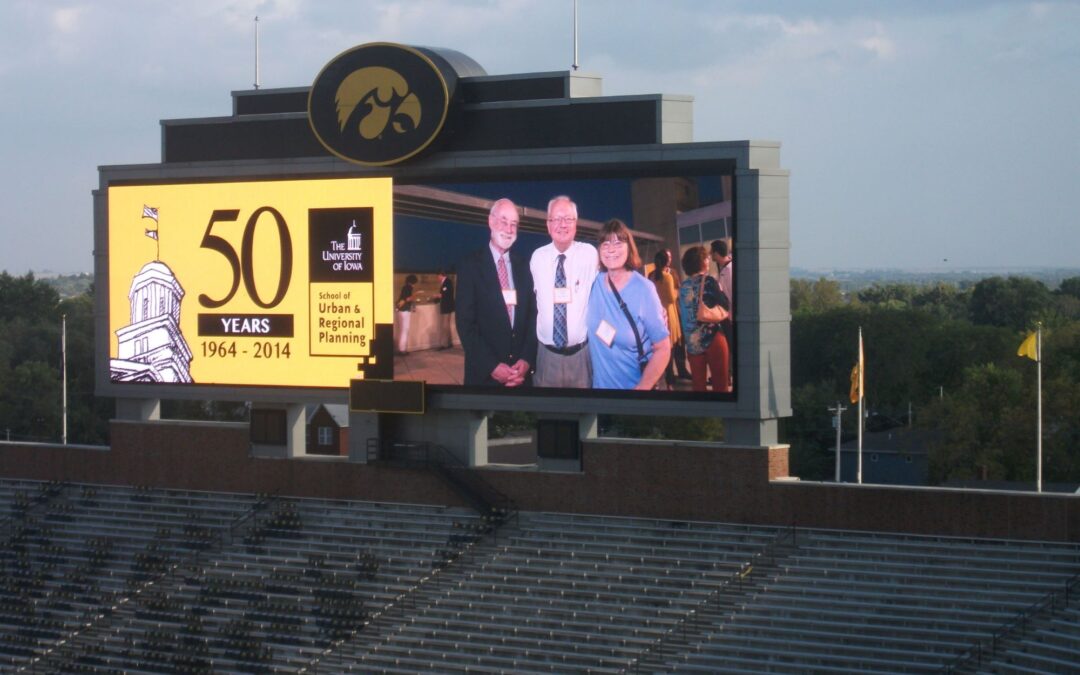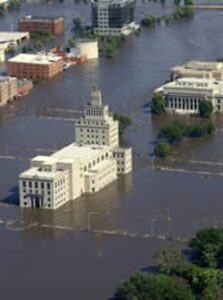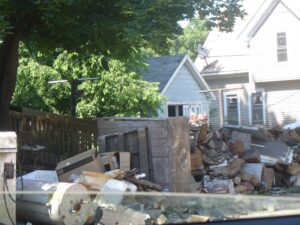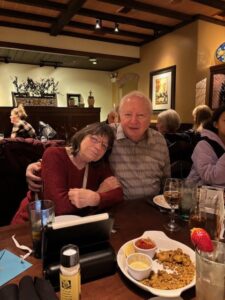About the time the rising Cedar River crested in downtown Cedar Rapids, Iowa, on June 13, 2008, a torrential downpour from an incoming thunderstorm joined forces with it to create the perfect flood. In the previous flood of record in the city, the river had reached 20 feet in depth, well above flood stage at 12 feet. Amid the double onslaught, the river this time rose to more than 31 feet, spreading across all of downtown and adjacent neighborhoods, swamping city government offices on Mays Island in the middle of the river, forcing the evacuation of fourteen percent of the city’s land area and 10,000 people from homes and businesses, and setting in motion an epic response and remarkable long-term recovery.
The flood in Cedar Rapids was not isolated. Cedar Falls, about 90 miles upstream from Cedar Rapids, had already experienced its own severe flooding, as had numerous small towns. The Iowa River, another tributary flowing southeast to the Mississippi River, flooded also, overwhelming defenses of several major buildings on the University of Iowa campus and neighborhoods in vulnerable areas, as well as in neighboring Coralville and, again, numerous small towns up and down the river corridor.
One result of all this devastation was the creation by the Iowa legislature of the Iowa Flood Center, housed since 2009 at the University of Iowa, following extensive conversations between legislative leaders and managers of the university’s Hydraulics Lab. The Flood Center continues its invaluable work to this day, contributing technical knowledge and awareness to numerous communities statewide that would never have state-of-the-art monitoring systems without such intervention. It has become a model that other states have visited and considered replicating to meet their own flood and climate challenges.
On a far smaller scale, another result emerged from the University of Iowa’s Department of Urban and Regional Planning, now known as the School of Planning and Public Affairs. With a new director arriving from Florida State University that summer, Dr. Charles Connerly, the faculty discussed how this graduate program could better assist students and Iowa communities to address the planning needs posed by natural disasters including, obviously, flooding, the most frequent and ubiquitous natural hazards issue facing the state, which is crisscrossed by dozens of tributaries and sub-tributaries of the Mississippi and Missouri Rivers. The idea of offering a course on disaster issues in planning arose and, along with it, the question of who could teach it.
It was at that point during the weeks after the flood, I was told, that Dr. John Fuller, my long-ago mentor and supervisor when I was a graduate student (in the early 1980s) and graduate research assistant for the (no longer extant) Institute of Urban and Regional Research, asked the question, “Why not bring back Jim Schwab?”
John had long been aware of my transformation over time into an expert on disaster issues, starting in the 1990s with an American Planning Association project funded by the Federal Emergency Management Agency, resulting in a 356-page report titled Planning for Post-Disaster Recovery and Reconstruction. Connerly had worked with a fellow professor at Florida State, Robert Deyle, who had contributed a case study to that publication. He also understood from Florida how critical good planning could be to the outcome of such disasters. He gave John the assignment of reaching out to me to assess my interest in taking on the part-time job of teaching such a course. I agreed to do it because it seemed an important opportunity to make a difference. Thus was born the course, “Planning for Disaster Mitigation and Recovery.”
There were definite wrinkles and challenges. The fall semester would start in the last week of August. Starting in late July that year, I would be gone for three weeks to New Zealand as a Visiting Fellow for the Center for Advanced Engineering in New Zealand (CAENZ) at the University of Canterbury in Christchurch. (The trip actually involved three weeks of moving around New Zealand to present seven lectures and seminars in multiple locations before completing a white paper for CAENZ on national planning for natural hazards.) Somehow, while preparing for the trip and in the two weeks following my return, and continuing my full-time position at APA as Manager of the Hazards Planning Center, I managed to stitch together the curriculum for the course, including a half-day field trip in December to visit several damaged buildings on campus and hear about post-flood restoration plans. I don’t honestly remember how many students we had that year, perhaps ten or twelve. I do recall that two or three other planning professors joined us on the tour.
That two-credit elective course for Master’s-level students did not stay that way for long. I no longer have all my records that far back, but in the spring of 2010, I believe, I participated in a symposium with planners from Cedar Rapids, public policy experts, and others focused on the recovery from the floods. Chuck Connerly approached me to say that there was demand among students to expand to a three-credit course, with an appropriate expansion in salary, and asked if I was willing to redesign the course accordingly. Again, I said yes, seeing an opportunity to more fully engage students on both hazard mitigation planning and disaster recovery. I incorporated a full-day field trip at the beginning of the course to Cedar Rapids, where the staff of the Community Development Department enthusiastically hosted us to discuss their flood recovery efforts. Toward the end of the semester, I added an all-day workshop that Chuck and I opened to practicing planners for continuing education credits under the American Institute of Certified Planners, innovatively mixing the practitioners with graduate students in small group exercises on mitigation and recovery. With help from planners in Cedar Falls, we originally used that community’s flood experience as a case study for small group exercises in the workshop. Years later, with help from Texas planners, we revised the workshop to use Rockport, Texas, and Hurricane Harvey as the case study, which we did again this year. Students had the option of taking the class for two credits without the workshop. Most opted for the full three-credit course.
Over time, as friends asked me about the course, I would comment wryly that I was “not teaching Shakespeare,” as a way of explaining that the subject matter was so dynamic that every year, I was examining ways to update the material to keep up with a rapidly changing subfield. New disasters brought new lessons in both mitigation and recovery, along with new federal and state legislation and programs that demanded my attention. Fortunately, much of this, if not most of it, overlapped with my ongoing career. That included overseeing a FEMA-supported project on incorporating hazard mitigation priorities throughout the local planning process, resulting in the 2010 publication, Hazard Mitigation: Integrating Best Practices into Planning. About the time that was finished, we were beginning another FEMA-supported project that led to the 2014 publication, Planning for Post-Disaster Recovery: Next Generation, accompanied by substantial online resources. And on it went until I finally retired from APA at the end of May 2017. Because the APA projects were often pushing the boundaries of the field, those publications became the textbooks for my course. I used other books as well, but no one had produced anything else with nearly as much practical learning value for the main components of my Iowa course. Students often liked the idea that their instructor had led the way in developing such materials. I would hasten to add that each of these involved several contributors, but nonetheless it was true that I had served as the project manager and general editor in each case.
What kept me going through all this? Over the past 16 years, I have come to realize that the course grew its own legacy. I cannot possibly keep track of what all the students from those years are doing now, but I know that some are enjoying great careers in the growing subfield of hazards planning. Without intentionally slighting anyone else, I would note that Kehla West, one of my earlier students, has been doing wonderful work on resilience and recovery for FEMA Region 5 here in Chicago. Robyn Fennig first took a position with Wisconsin Emergency Management, then with the Association of State Floodplain Managers, then back to the State of Wisconsin as its State Hazard Mitigation Officer, and is now with the California Office of Emergency Services, enjoying a stellar career. Rebecca Leitschuh was not in my Iowa class, but was in a very similar one I co-taught in 2007 and 2009 at the University of Illinois-Chicago. She is now the infrastructure resilience lead with Stantec, a consulting firm. Rebecca also worked for me at APA back then as a graduate student intern. And Emily Seiple in 2017 won a national student paper contest with a paper on disaster recovery she had written for my course the previous fall. All of this exposure to promising young professionals has encouraged me and boosted my spirits in the face of the work involved in making this course happen over the past 16 years.
There have been some unexpected challenges along the way. For many years, until 2019, I mostly taught in person, using a specially crafted schedule that accommodated my duties in Chicago. I typically drove to Iowa City for day-long lecture sessions on a Friday, usually staying overnight with John Fuller and his wife, Kathy, in nearby West Branch. But as of 2019, we shifted to weekly online classes, regrettably ditching the field trip in the process. By then, I was no longer at APA, but I was consulting and writing in what I jokingly labeled “alleged retirement.” The planning school added a master’s degree in Public Affairs, thus renaming itself the School of Planning and Public Affairs. In 2023, amid some adjustment in the overall program as a result, I did not teach the course, but my own prostate surgery in late September, which entailed three months of patient recovery, would probably have made that an impossible burden. In the meantime, current SPPA director Haifeng Qian asked me to redesign the course to meet the needs of both planning and public affairs students, something I did this past spring, mostly by shedding some material on mitigation and recovery and adding a module on disaster insurance.
I was in for a shock as summer wore on. As best I can recall, my largest previous class had twelve students, not a bad number for an elective graduate class that required students to produce two major papers. By mid-August, I realized that this year I would have 21 students, clearly a record buster for my course. This virtually guaranteed some longevity for the course, which was heartwarming.

John Fuller and Jim and Jean Schwab appear on the Jumbotron at Kinnick Stadium, Iowa City, during 50th anniversary of Iowa planning program
But time was catching up with me, and I could feel the burden as the semester wore on. With eight practitioners enrolling for CM credits, my two volunteer co-facilitators (Carol Barrett and Amanda Torres) and I were hosting 29 participants in the day-long workshop on November 16. All those papers, some of them excellent, started pouring in. Other work did not go away. I began to realize that maybe I did not want to do this again. More importantly, as a result of the growth of the hazards planning and resilience subfield, there was more promise that someone could take my place than had been the case ten or fifteen years ago. I thought deeply about the future, about the other things I wanted to accomplish while I had the chance, and wrote to Haifeng to say that I wanted to make this my last year. I have long believed that it is important to know when it is time to move on and not to be afraid to do so. Haifeng responded graciously with an all-caps “THANK YOU!!” for my years of service. In his reply message, he invited me to attend the upcoming 60th anniversary of the University of Iowa planning program, which I promised to do. I will remain a loyal Hawkeye planner. I would not miss this celebration for anything.
I had looked at the calendar and seen a stunning coincidence. The last day of the semester was December 20, which was also my 75th birthday. I took that coincidence as a sign from the universe that it was a good time to move on. It was God’s Christmas gift to me, offering me the liberty to do new things. One involves writing a book I promised to a literary agent with whom I worked years ago, a mashup of a professional memoir and planning history. Stay tuned. I will also work tirelessly to ensure the completion of Planning to Turn the Tide, the documentary film project of the APA Hazard Mitigation and Disaster Recovery Planning Division. (See new trailer here.) Those two projects are my dominant priorities for 2025. They are not the end of the road, just the newest way of looking ahead. Ideally, they will also leave time for reading more books, traveling with my wife, meeting with friends, and helping family for at least couple of more decades.
Jim Schwab



